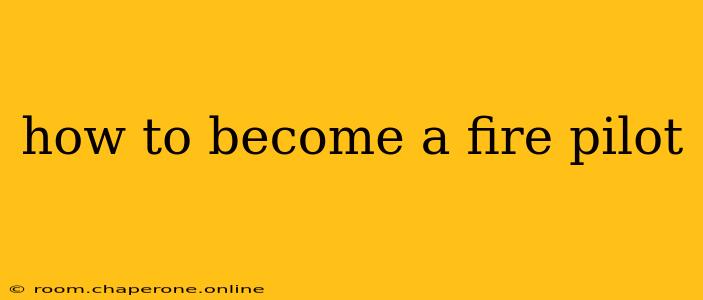Becoming a fire pilot, also known as an aerial firefighter, isn't just about a love of flying; it demands a unique blend of piloting skills, unwavering courage, and a deep commitment to protecting lives and property. This comprehensive guide outlines the path to achieving this challenging yet incredibly rewarding career.
Understanding the Role of a Fire Pilot
Fire pilots are at the forefront of wildfire suppression. They operate a variety of aircraft, including air tankers (large planes dropping retardant), helicopters (for water bucket drops and more precise maneuvers), and single-engine air tankers (SEATs) – often used for initial attack. Their responsibilities extend beyond simply flying; they need to understand fire behavior, weather patterns, and effective strategies for aerial firefighting. This requires intense training and ongoing proficiency.
The Path to Becoming a Fire Pilot: A Step-by-Step Approach
This journey requires significant dedication and commitment. Here's a breakdown of the necessary steps:
1. Obtain the Necessary Flight Training and Licenses:
- Commercial Pilot License (CPL): This is the foundation. You'll need extensive flight training covering various aspects of piloting, including navigation, meteorology, and regulations.
- Instrument Rating (IR): Essential for flying in low visibility conditions, which are common during firefighting operations, especially in smoky environments.
- Multi-Engine Rating (if applicable): Required if you plan to operate larger air tankers.
- Type Rating (if applicable): Specific type ratings are needed for certain aircraft models used in aerial firefighting.
2. Gain Experience:
Accumulating flight hours is crucial. While minimum requirements vary depending on the specific aircraft and employer, significant flight experience in various conditions is highly valued. Consider these avenues:
- Charter Flying: This offers valuable experience in diverse environments and builds proficiency in handling various situations.
- Aerial Application: Experience in aerial agriculture (crop dusting) can provide relevant skills in low-level maneuvering and precise payload delivery.
- Flight Instruction: Becoming a flight instructor not only builds hours but also strengthens your understanding of flight principles and safety procedures.
3. Develop Essential Skills Beyond Piloting:
- Firefighting Knowledge: Understanding fire behavior, suppression techniques, and the strategic aspects of aerial firefighting is paramount. Many organizations offer specialized training courses.
- Navigation and Communication: Excellent navigation skills, especially in challenging terrain and low-visibility conditions, are indispensable. Clear and concise communication with ground crews is equally critical.
- Physical Fitness: This demanding role requires excellent physical and mental stamina. Maintaining peak physical fitness is essential for handling the stresses of the job.
4. Seek Employment Opportunities:
- Private Aerial Firefighting Companies: Many private companies specialize in aerial firefighting and often hire pilots with relevant experience.
- Government Agencies: Federal, state, and local agencies involved in wildfire management also employ fire pilots. These opportunities often involve competitive application processes.
5. Ongoing Training and Proficiency:
Once employed, continuous training and proficiency checks are essential to maintain your skills and certifications. Staying up-to-date with the latest techniques and safety protocols is crucial for this high-risk profession.
Key Considerations and Challenges:
- Competitive Field: The number of qualified candidates often exceeds the available positions.
- High-Risk Environment: Aerial firefighting is inherently dangerous, requiring courage, discipline, and exceptional judgment.
- Irregular Work Schedule: Firefighting often requires long hours and deployment to various locations based on wildfire activity.
Conclusion:
Becoming a fire pilot is a demanding but immensely rewarding career. It requires a potent combination of flying skills, firefighting knowledge, and unwavering dedication. By meticulously following these steps and maintaining a commitment to continuous learning, aspiring pilots can embark on a path toward making a significant contribution to protecting communities and preserving our natural resources. Remember, research specific requirements and contact relevant agencies and companies for the most up-to-date information on qualifications and application procedures.

